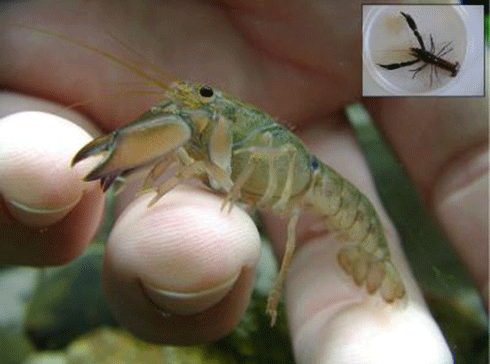
|
Published: 14 April 2014
Volunteers detect new species living in the midst of growth zone
Hidden in one of Australia's most developed and fastest growing areas lives one of the world's smallest freshwater crayfish species.

|
|
The eastern swamp crayfish Gramastacus lacus from the Lake Macquarie catchment. Credit:
Rob McCormack under CC-BY 4.0 licence
|
Robert McCormack the Team Leader for the Australian Crayfish Project described the new species belonging to the genus Gramastacus, after 8 years of research in the swamps and creeks of coastal NSW.
The study was published in the open access journal ZooKeys.
Being so tiny, the crayfish species has remained undescribed and undiscovered in one of the fastest developing regions of Australia. Only one other species of Gramastacus crayfish is known, and it occurs some 900 km away in the Grampians region of Victoria.
The new species is found in lowland ephemeral habitats surrounding coastal lakes and lagoons from Wamberal Lagoon, north along the coastal strip to Wallis Lake between Newcastle and Port Macquarie. Being dependent on regular natural flooding and drying cycles, the crayfish is only found in lowland, swampy areas.
To survive the drying cycle, each crayfish digs a small rounded cross-section burrow up to one metre deep into the water table.
The newly described crayfish are found in one of Australia's most developed regions. Unfortunately, this means that much of their habitat has been lost as these ephemeral areas are the first to be drained or reclaimed for agriculture, industry, housing developments, golf courses, infrastructure, etc.
Now, being found and officially described, McCormack and his colleagues say this crayfish should be considered in future developments to reduce further loss of habitat loss.
The scattered, fragmented populations of Gramastacus are increasingly threatened by a range of risks other than human development – invasive crayfish, pest fish species like plague minnows and swordtails, rising sea levels and falling water tables. However, present-day national parks and reserves in the region provide safe refuges for some populations.
The
According to the ACP, Australia has one of the most diverse ranges of freshwater crayfish species on the planet, yet there is confusion about the description and distribution of species and many species remain undiscovered and undescribed. Freshwater crayfish are important keystone species that play a critical role in maintaining the health and structure of freshwater habitat for macroinvertebrates, fish, eels, turtles, lizards, snakes, water rats, platypus and birds.
Source: Australian Crayfish Project



